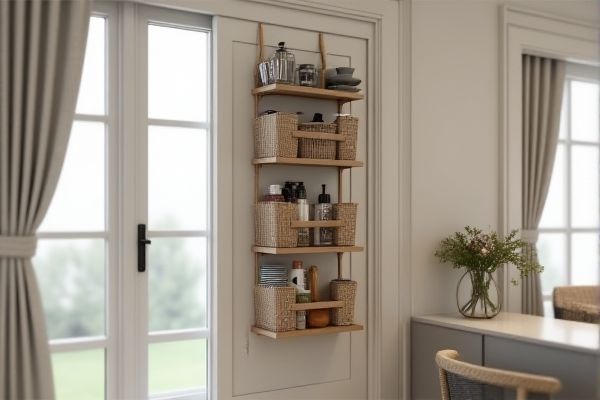
Over-the-door organizers maximize vertical space by hanging directly on doors, providing easy access to frequently used items, while hanging shelf organizers offer multiple compartments suspended from rods or hooks, ideal for structured storage of clothes or accessories. Discover which organizer best suits Your space and needs by reading the rest of the article.
Table of Comparison
| Feature | Over-the-Door Organizer | Hanging Shelf Organizer |
|---|---|---|
| Installation | Hooks directly over door, no tools needed | Hangs from ceiling or closet rod, may require hooks or chains |
| Storage Type | Multiple pockets or compartments for small items | Open shelves suitable for folded clothes, boxes, or bulkier items |
| Space Efficiency | Utilizes door space efficiently, ideal for tight areas | Maximizes vertical space, better for closets with height clearance |
| Weight Capacity | Lightweight items (shoes, accessories) | Can support heavier items depending on material and installation |
| Portability | Easy to remove and relocate | Less portable, more fixed installation |
| Common Uses | Shoes, small accessories, toiletries | Clothes, storage bins, books |
Introduction to Over-the-Door and Hanging Shelf Organizers
Over-the-door organizers utilize vertical space by hanging directly over doors, providing accessible storage for shoes, accessories, or toiletries without floor clutter. Hanging shelf organizers feature multiple compartments suspended from closet rods or hooks, ideal for folded clothes, bags, or small items, maximizing vertical storage in closets. Both solutions enhance organization in compact areas but differ in installation style and storage capacity.
Design and Structure Comparison
Over-the-door organizers feature a slim design with hooks that hang securely over door tops, maximizing vertical space without permanent installation. Hanging shelf organizers typically employ fabric or wire shelves suspended from rods or hooks, offering multiple tiers for compartmentalized storage. The rigid frame of over-the-door organizers provides sturdy support for heavier items, whereas hanging shelf organizers excel in flexible storage for lightweight goods.
Installation Process and Requirements
Over-the-door organizers require a simple installation process involving hooks that hang over the door without the need for tools, suitable for most standard interior doors with a thickness of 1.375 to 1.75 inches. Hanging shelf organizers typically use adjustable straps or brackets that secure to closet rods or wall-mounted hooks, necessitating anchor points and sometimes mounting hardware for stability. Installation for hanging shelf organizers demands a suitable support structure capable of bearing weight, while over-the-door options rely solely on door strength and clearance space.
Space-Saving Capabilities
Over-the-door organizers maximize vertical space by utilizing unused door surfaces, making them ideal for small rooms and tight areas. Hanging shelf organizers offer versatile storage by suspending multiple tiers, efficiently sorting items without occupying floor space. Both solutions enhance space-saving capabilities but differ in accessibility and storage capacity based on room layout and user needs.
Weight Capacity and Durability
Over-the-door organizers typically support moderate weight loads ranging from 10 to 30 pounds, making them ideal for lightweight items such as scarves or small accessories. Hanging shelf organizers often feature reinforced fabric and sturdy metal frames, providing higher weight capacities up to 40 pounds per shelf, which suits bulkier items like sweaters or shoes. Choosing the right option depends on your storage needs and the durability required to safely hold your belongings.
Versatility and Common Uses
Over-the-door organizers offer high versatility by fitting securely on most standard doors, making them ideal for storing shoes, accessories, or cleaning supplies in entryways and closets. Hanging shelf organizers provide multiple compartments or cubbies, perfect for organizing folded clothes, toys, or pantry items in bedrooms, playrooms, and kitchens. Both options maximize vertical space, but hanging shelf organizers often accommodate heavier items due to their sturdier design.
Accessibility and Convenience
Over-the-door organizers provide easy accessibility by utilizing unused door space, allowing items to be quickly grabbed without bending or reaching far. Hanging shelf organizers offer convenience through multiple tiered compartments, enabling efficient organization and easy visibility of stored items. Both options maximize space, but over-the-door organizers are often preferred for quick access in tight spaces.
Aesthetic Appeal and Style Options
Over-the-door organizers offer a sleek, space-saving solution with minimalist designs that blend seamlessly into most room decors, making them ideal for maintaining a clean and unobtrusive aesthetic. Hanging shelf organizers provide more visible and customizable storage options with various colors, patterns, and materials that can enhance the overall style of your space. Your choice depends on whether you prefer subtle functionality or decorative versatility to complement your room's interior design.
Price Comparison and Budget Considerations
Over-the-door organizers generally come at a lower price point, making them a cost-effective option for budget-conscious buyers seeking simple storage solutions. Hanging shelf organizers, while typically more expensive, offer added versatility and increased storage capacity that may justify the higher investment for Your space needs. Comparing costs alongside the functionality and durability of each organizer helps determine the best option without exceeding budget limits.
Which Organizer Is Best for Your Needs?
Over-the-door organizers maximize vertical space by hanging on door hooks, ideal for small rooms or temporary storage without wall damage. Hanging shelf organizers offer more compartmentalized storage, perfect for closets or areas where additional shelving can stay permanently. Choose an over-the-door organizer for easy installation and portability, while hanging shelf organizers benefit users needing structured, multi-level organization.
 homyna.com
homyna.com